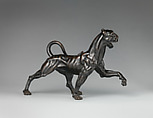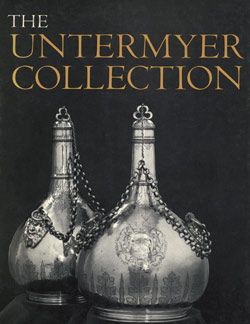Panther
Not on view
Conventional wisdom and the supposition that naturalism started in Padua led this model to be assigned to northern Italy in the early sixteenth century, an assessment supported by a pride of related felines, variously datable from the late sixteenth to the late eighteenth century, with classical and Mannerist origins.[1] The 1624 inventory of the Delft silversmith Thomas Cruse listed a “form van den Tiger van Tettero,” i.e., a mold of the tiger by Willem van Tetrode, the Italian-trained Dutch Mannerist.[2] This work, with its streamlined, diagonal composition and relatively short neck, corresponds to a type represented by examples in the Herzog Anton Ulrich Museum, Braunschweig, and the Museum Boijmans Van Beuningen, Rotterdam.[3] The French sculptor François Girardon owned a statuette of the same lithe model, engraved before 1709 and called a leopard.[4] It prefigures but does not form a true match to our Panther, which is more aggressive, more emphatically muscled, and has almost the appearance of a flayed beast, so evident is its underlying anatomy.
Felines of this second, more common type were first associated with Giovanni Zoffoli.[5] A “notomia di tigre” (anatomy of a tiger) occurs in Zoffoli’s product list of about 1795, offered for sale at 10 zecchini.[6] The title reflects the écorché-like effect of our model. If really meant for a tiger—or a leopard, for that matter—the skin’s markings would have vanished in creating this flayed effect. The name “panther” is perhaps best because it covers most of the largest cats and because panthers so often appear in the Bacchic subjects familiar to Neoclassical generations. In any case, Zoffoli’s connection with the production is certified by the existence of one example signed on the base.[7] Ours is distinguished by the tail elegantly looped along the proper left flank, the vivid modeling of the head and teeth, and a patina not dissimilar to that of cat. 179.[8]
-JDD
Footnotes
(For key to shortened references see bibliography in Allen, Italian Renaissance and Baroque Bronzes in The Metropolitan Museum of Art. NY: The Metropolitan Museum of Art, 2022.)
1. For the northern Italian attribution, see Bode 1908–12, vol. 3, pl. CCXLVIII (but see Bode and Draper 1980, p. 109, “probably by Giovanni Zoffoli”); Planiscig 1930, p. 87, no. 146. For the group of felines, see Berger and Krahn 1994, p. 160, no. 121. Ancient bronzes could have prompted both the extended front paw and the svelte stretch. See Ridder 1913, p. 58, nos. 913, 914.
2. See Scholten 2003, pp. 35, 126, and references cited therein.
3. Ibid., p. 126, cat. 33; Berger and Krahn 1994, pp. 160–63, no. 121.
4. Souchal 1973, p. 9, no. 441, pl. III, recorded from both sides, and pp. 44–45. The shorter neck and lowered tail make it clear that Girardon’s bronze was of this earlier type, not the one Souchal illustrates (fig. 43), a Louvre example of our type.
5. Weihrauch 1967, p. 435, fig. 516, discusses an example then on the market, very likely also by Zoffoli.
6. Haskell and Penny 1981, p. 342.
7. Christie’s, London, December 11, 1978, lot 105a.
8. Richard Stone describes the muzzle and teeth as “curious” and notes that the cast is exceedingly thin and even, suggesting it may date to the nineteenth century. The metal is a quaternary alloy of copper, zinc, lead, and tin, with trace impurities. R. Stone/TR, 2014.
This image cannot be enlarged, viewed at full screen, or downloaded.
This artwork is meant to be viewed from right to left. Scroll left to view more.





